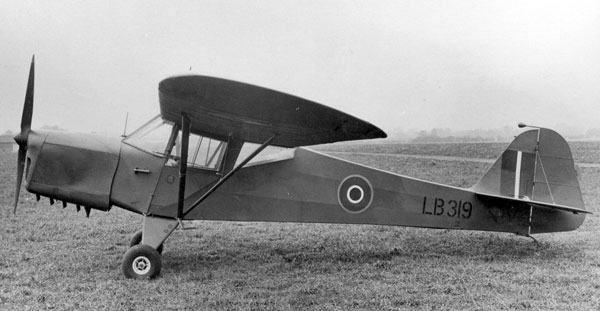
This aircraft belonged to No.658 Air Observation Post (A.O.P.) Squadron who worked closely with army units in artillery spotting from the air during the Army training in the UK and later in the advance in France following D-Day. The squadron moved around England fairly frequently during the latter part of 1943 and various parts or "Flights of the squadron were also sent on detachment to other airfields or to advanced landing grounds nearer the army ranges across the country. The advanced landing grounds were temporary landing sites nearer the ranges than their home airfields and were basically quickly converted farmer's fields. The North York Moors was used by the Army for training and in the area of these ranges on the eastern side of the North York Moors at least three of advanced landing grounds were created; sites in the Hackness, Silpho and Snainton areas have been traced.
Between 26th and 29th October 1943 the 658 Squadron record book states that one of their aircraft carried out exercises on the Saltergate and/or Spaunton ranges where they did 26 shoots with regiments of the Guards Armoured Division during the first two days. On 28th October 1943 the aircraft was being used in the Saltersgate area when fog developed up over the ranges whilst this pilot was in the air and about to do the first shoot of the day. The pilot attempted to locate the advanced landing ground where he was stationed in visibility of about ten yards but was unable to locate it so forced landed in a stubble field a few miles from the landing site. The aircraft received no damage as a result of this incident. As the known landing sites were in the Snainto, Silpho and Hackness areas I assume the part had attempted to find one of these sites but force landed in a field near one of the villages. Fog prevented the squadron from returning to York until 30th October 1943.
This incident could relate to one recounted in a small book on local history of the nearby village of Brompton by Sawdon. In this book reference is made to an Auster landing in the area of Wydale Hall.
Pilot - Captain R P Nelson RA (78698). Uninjured.
The pilot was serving in the Territorial Force of the Army prior to the outbreak of the Second World War in the Essex Fortress Royal Engineers and was transferred to the Royal Engineers (T.A) on 1st April 1939 while in the rank of 2nd Lt. On 1st August 1941 he transferred to the Royal Artillery (T.A.) on 1st August 1941 and almost certainly was seconded to the RAF in 1943. Captain Nelson was posted 658 Squadron on 17th September 1943 from 43 OTU at Old Sarum but only served with 658 Squadron until 20th November 1943 when their record book states that he left for embarkation leave prior to posting elsewhere. Nothing more about his service is yet known other than he survived the War and remained in the T.A. On 12th April 1961 having exceeded the age limit he ceased to belong to the T.A. Reserve of Officers, he was in the rank of Captain (Hon Major) but was permitted to retain the rank of Hon Major.
A Richard P Nelson was born in the Billericay area of Essex in 1911 and may well be the same person, and probably married in Chelmsford in 1937.